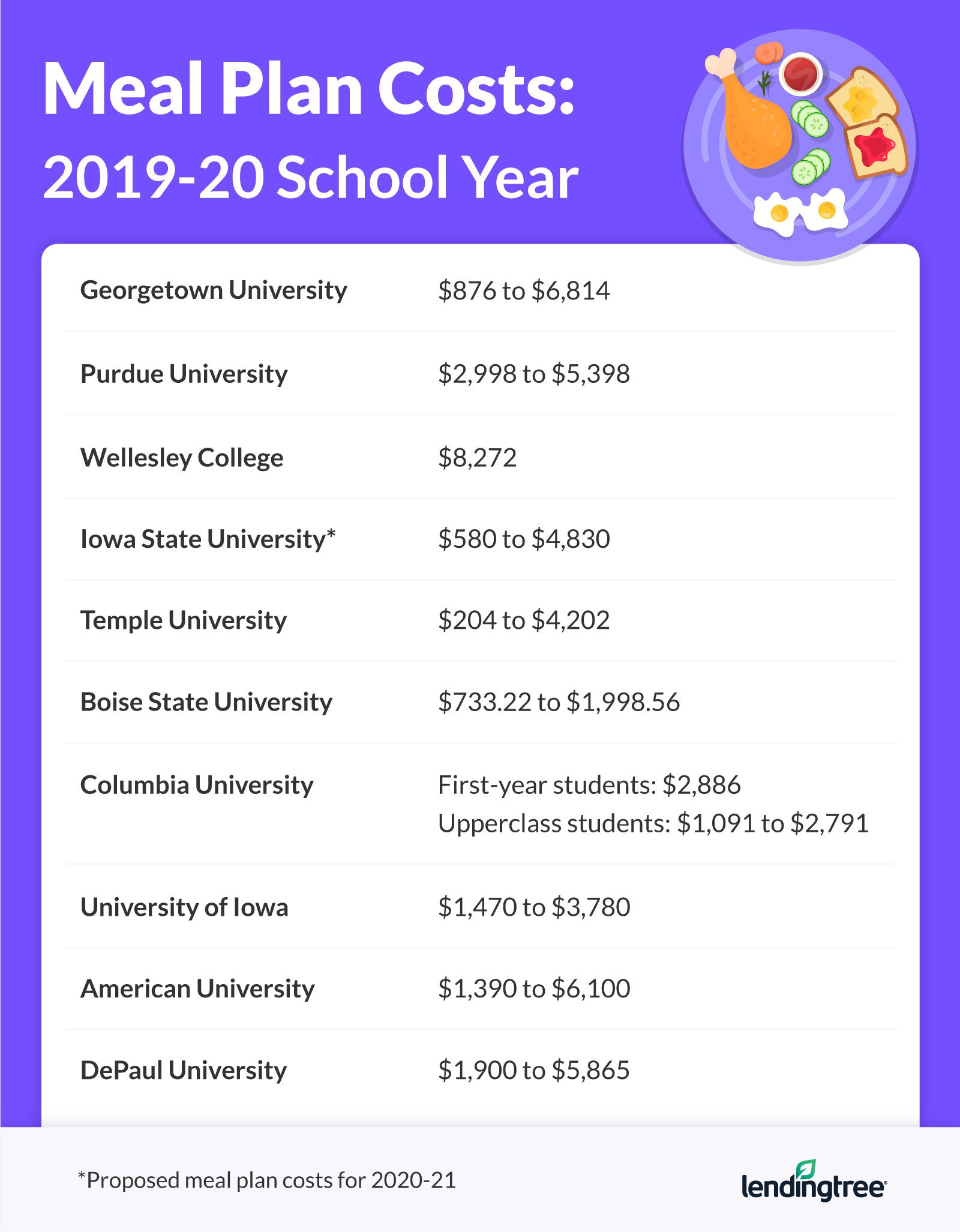Are Meal Plans Worth It for College Students?
The short answer to the important college question “Are meal plans worth it?” is that it depends. You could find yourself asking this if you live on campus (or off-campus), if schoolwork keeps you from preparing food or if you have zero culinary talent.
College meal plans are a convenient solution if you don’t want to cook the night before a big exam. However, with 69% of college students taking out student loans to pay for school, squeezing dining plan costs into an already tight budget can be challenging.
Are meal plans worth it? 4 questions to ask
1. How much does a college meal plan cost?
A spring and fall semester meal plan for college students costs anywhere from $876 to $8,272 among the 10 universities we examined. Below are meal plan costs from those 10 colleges across the U.S. (Note that some colleges offer meal blocks — for example, 25 meals a semester — in addition to meal plans, so that’s why you may see smaller low-end ranges with some of the schools.)
Not having to cook your own meals is a benefit that comes at a steep price. As the table shows, meal plans tack thousands of dollars onto your total college expenses each year.
Graduate student Drew DuBoff, who attends Johnson & Wales University in Providence, R.I., said the dining plan cost is worth it — and he has a degree in culinary arts.
While studying as an undergraduate at Johnson & Wales, he purchased a meal plan that included:
- 10 weekly meal swipes
- $600 flex dollars
Flex dollars were loaded onto his student ID — like how a debit card is used — and spent at on-campus, grab-and-go eateries. The total annual cost of his meal plan was $3,474, which amounted to about $8.50 per meal, according to DuBoff’s calculations.
“I do feel that I saved money because I easily would have spent more than $8.50 on a meal outside the university,” said DuBoff, owner of Quizzalicious, a service that helps entrepreneurs build online quizzes. “I think that the quality of food was very reasonable for the cost and I can’t 100% say that I would be able to cook a meal from scratch, have it taste that good — in such a short time — and keep it on budget.”
DuBoff worked part-time for campus dining, too, so he was able to get three to five free meals a week depending on his schedule.
2. Will unused meals roll over to the next semester or school year?
Each school’s dining plan policy differs. For example, block meals at the University of California, Irvine can’t be rolled over to the next quarter, but flex dollars can be rolled over as long as they’re spent by the end of the spring quarter.
Before signing up for a college meal plan, think about how many times you’ll realistically eat on campus. One way to approach this is to ask yourself how often you’ll be on campus. If you work part-time, have off-campus activities or take classes at odd hours, you may lose out on your prepaid meals.
3. What kind of hours and flexibility does the meal plan offer?
College meal plans offer a communal experience for students in the dining hall. However, on-campus dining halls, restaurants and snack shops post business hours so you know your options.
For example, at California State University, Northridge, the closest dining hall to the dormitories is Geronimo’s, which opens at 7 a.m. Monday through Friday. If you have an early morning work shift or class at 7 a.m., you won’t be able to catch breakfast before starting your day. This is another reason why it’s important to consider timing before buying a meal plan.
Your school may have terms and conditions that offer more flexibility when claiming your meals. For example, some schools, such as the University of California, Irvine, allow limited carry-out from the dining hall, while other colleges, such as the University of Iowa, don’t allow carryout.
4. Does living off-campus make my meal plan cheaper?
Living off-campus can mean you have access to cheaper meal plans, but not always. At the University of Arkansas, the most expensive plan for on-campus students is $2,185 a semester, which has no weekly meal limit and includes $150 dining dollars. By comparison, the most expensive dining plan for off-campus students is $848 a semester for 50 total meals and $500 dining dollars.
Frequently asked questions
If you’re a first-year student, your school may require you to purchase a meal plan. For example, Temple University requires new students to have a minimum plan of 10 meals a week.
Schools that enforce a mandatory college meal plan may require a valid reason and documentation before approving an exemption from the dining plan. For example, if you provide a doctor’s note stating that you have special dietary needs that the dining hall can’t accommodate, you may be off the hook.
It depends. Aside from grabbing a bite to eat, communing with peers over a meal can build camaraderie at a new school, possibly enhancing the college experience. From a financial perspective, the cost per meal may be pricey if you’re OK spending the time to shop for groceries and cook. Also, if you prefer simple meals, such as a bowl of cereal for breakfast, a meal plan that charges you $8.50 for it may not be budget-friendly.
Some colleges include the meal plan cost in room-and-board charges.
No, college meal plan costs are not tax-deductible. According to the IRS, expenses such as transportation, insurance, and room and board (which meal plans may be baked into) aren’t considered a deductible education expense.



